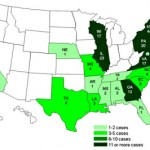 The Center for Science in the Public Interest (CSPI) has released a new review of foodborne illness outbreaks. They found that from 2001 to 2010, the latest period for which data is available, outbreaks related to E. coli, Salmonella, and other pathogens decreased by more than 40%. This may be because of better food safety practices, including the adoption of Hazard Analysis and Critical Control Points (HACCP) programs in the meat, poultry, and seafood industries, as specified by the government.
The Center for Science in the Public Interest (CSPI) has released a new review of foodborne illness outbreaks. They found that from 2001 to 2010, the latest period for which data is available, outbreaks related to E. coli, Salmonella, and other pathogens decreased by more than 40%. This may be because of better food safety practices, including the adoption of Hazard Analysis and Critical Control Points (HACCP) programs in the meat, poultry, and seafood industries, as specified by the government.
But the agency warns that incomplete reporting by public health agencies stretched and overworked by budget cuts may have influenced the data. CSPI food safety director Caroline Smith DeWaal said, “despite progress made by the industry and by food safety regulators, contaminated food is still causing too many illnesses, visits to the emergency room, and deaths. Yet state and local health departments and federal food safety programs always seem to be on the chopping block. Those financial pressures not only threaten the progress we’ve made on food safety, but threaten our very understanding of which foods and which pathogens are making people sick.”
In addition, foodborne illnesses are notoriously underreported. In fact, the CDC multiplies outbreak numbers by 30 in most cases to get the actual numbers of illnesses in most outbreaks.
CSPI also states that there is a decline in the extent to which reports of foodborne illness are fully investigated. An outbreak is considered “fully investigated” when the food and the pathogen responsible for the outbreak are identified. But during that same ten year period, the percentage of fully investigated outbreaks declined from 46% in 2001 to 33% in 2010. You can search for foodborne illness outbreaks at the CSPI Outbreak Alert! Database.
Seafood, poultry, and beef had the sharpest declines in the number of outbreaks. Outbreaks related to produce remained flat. And illnesses related to dairy reached their highest point in 2010. CSPI says, “the increased availability of raw, unpasteurized milk and cheese may account for this; these products are inherently hazardous and should not be consumed at all.”
And here’s an interesting fact: foods regulated by the FDA, which include produce, seafood, dairy, and most packaged foods, were responsible for more than twice as many outbreaks as the meat and poultry regulated by the USDA. The FDA is currently developing regulations to comply with the Food Safety Modernization Act, which was signed into law in 2011.




